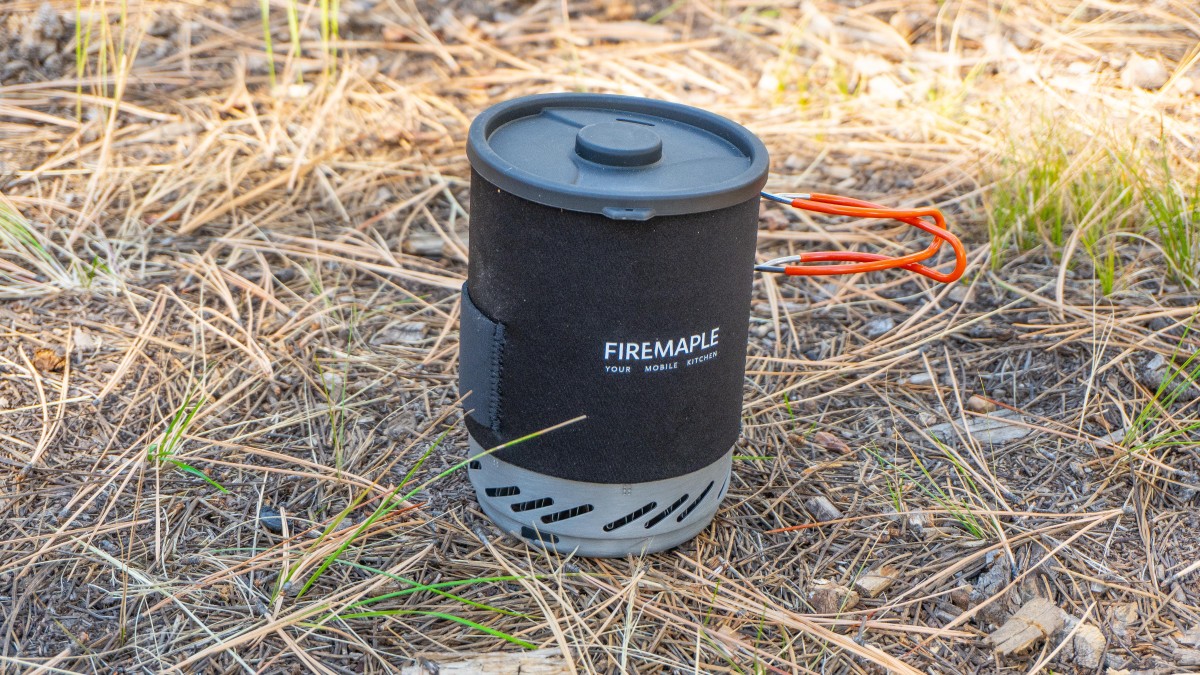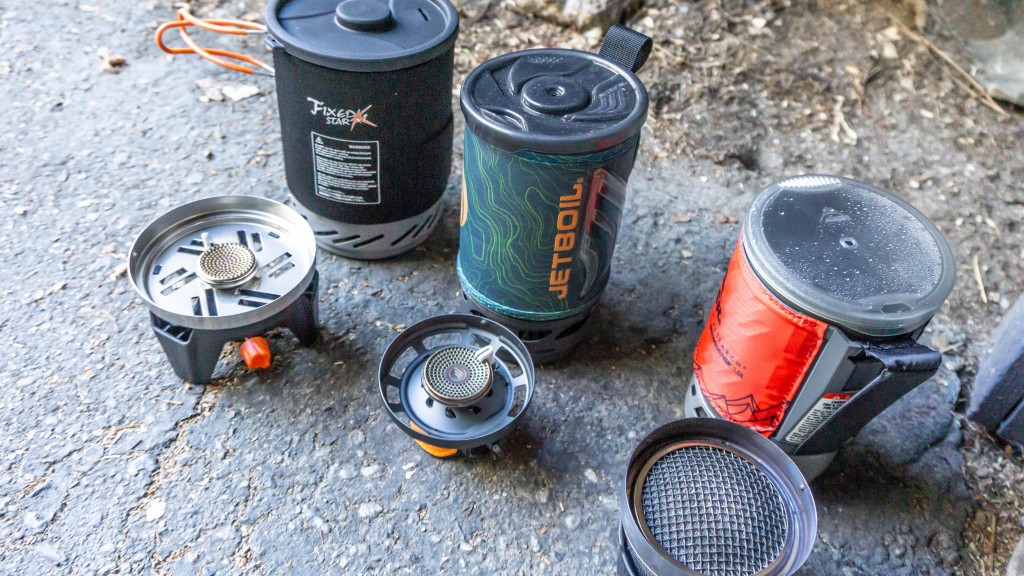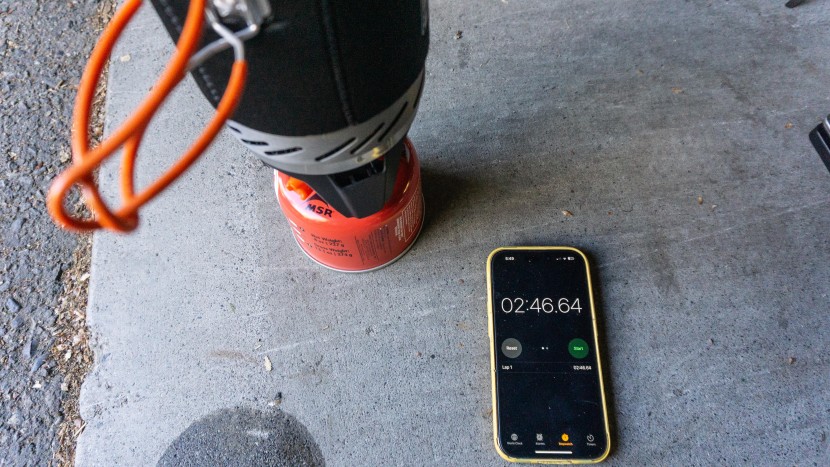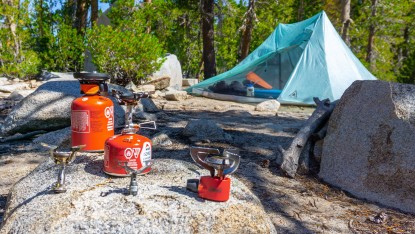
Our Verdict
Our Analysis and Test Results
Sure, the Fire Maple Fixed Star 1 isn't going to take home any awards in boil times or fuel efficiency, but its low price got our team's attention. Keep reading if you're shopping for an integrated canister stove on a skinny wallet.
Fuel Efficiency
For a night or two, you're unlikely to notice the fuel efficiency of the Fire Maple, but if you're going for a longer trip, make sure to bring a bit more fuel just to be safe. While it didn't take home a blue ribbon, this stove beat out some of the competition that was much pricier.
The Fire Maple used an average of .25 ounces of isobutane per boil throughout our lab testing, making it a “good enough” stove in the realm of fuel efficiency. While many integrated canister stoves emerged as truly fuel-efficient options, this model's performance was closer to a regular canister stove's, which commonly had less efficient heat transfer from the burner to the pot. Throughout field testing, we found similar results to our lab examination, and still believe most campers won't notice the fuel efficiency of the Fire Maple on shorter-length trips.
Weight
Depending on your intended uses, a backpacking stove's weight will have a varying degree of importance. If you're carrying the Fire Maple just a couple miles from the car, its scale scores might not be as big of a deal, but if your camping aspirations include more remote areas, its weight is worth pondering before you make a purchase.
The Fire Maple weighs a hefty 15.7 ounces for only the essentials: pot, lid, and a stove. The lightest integrated canister models we tested landed closer to the 7-ounce range, but again, these alternative options will strain the wallet much more. Fortunately, if you're looking to car camp or keep the backpacking aspirations modest, the weight of the Fire Maple should be less of a deal breaker. If you want to bring this model's included cup along, the total weight comes to 17.7 ounces, not including fuel.
Simmering Ability
We encourage you to carefully consider what kind of meals you'll be making in the backcountry to determine how crucial simmering ability is for your next backcountry stove. For most integrated canister stoves like the Fire Maple, boiling water for freeze-dried breakfasts and dinners is the recommended use. For slow-cooking veggies or toasting bread for a grilled cheese sandwich, you're going to have a much tougher time with the Fire Maple.
The Fire Maple isn't very “simmering friendly”, but there are a few hacks that can give you a break from freeze-dried meals. Our main go-to for making an integrated stove work for more involved dishes is to simply hold the skillet or pot higher above the burner's head. While this can be tiring, it's a nice way to mix up the menu without having to shell out more cash for a model with better simmering. Alternatively, utilizing some stones to serve as a makeshift stove platform can keep the cookware further from the heat, though make sure the stones are well-seated so they don't knock the burner or the cookware over. The simmer-required meals we had the most success with while using the Fire Maple included noodles and mac-n-cheese, and if you have to, skillet meals like quesadillas are also possible.
Wind Resistance
We found the Fire Maple to perform fairly well while examining its wind resistance, but there are several other stoves we'd steer you towards if needing a higher scoring option. However, in more sheltered camps and at lower elevations, you're likely to be just fine with the Fire Maple's performance on blustery trips.
With our box fan testing, we saw a 25% reduction in fuel efficiency. This was about average across our entire lineup, but we saw the Fire Maple fall further back in the field. When discussing our findings, our team agreed the primary issue was likely the burner head's modest size, which simply didn't put out as much heat as some of the other options in its stove class. There was some protection from the wind with the integrated pot, but it just wasn't quite as resilient as we would have liked.
Ease Of Use
One of our favorite aspects of the Fire Maple is its ease of use. The pot dimensions are on the wider side, helping alleviate tip-over, and it has a great neoprene wrapping to reduce the likelihood of a burn.
Our entire team loved the handle length, which allowed for easier pouring. When not in use, the handle's two sections simply fold in and hug the curvature of the pot. The cup included with the Fire Maple wasn't our favorite, as it only fits inside the pot rather than clicking into the outside of the pot's bottom, which was common in other brands. We felt like the 2-ounce cup was best left at home, with better-performing mugs and water bottles already on the packing list.
Should You Buy the Fire Maple Fixed Star 1?
If the Fire Maple is in your budget and you really want the heat transfer of an integrated canister stove, toss it in your shopping cart. There are several other models that perform better in metrics like fuel efficiency or weight, but you'll end up paying much more for an integrated canister model.
What Other Backpacking Stoves Should You Consider?
For a basic backpacking stove, the tiny and uber-affordable BRS-3000T is worth checking out. If you've determined that saving up for a higher-performing stove is a worthwhile priority, check out the Jetboil Stash if fuel efficiency and weight are important to you. If you're still hunting for a good bargain, consider the Soto Amicus, which isn't an integrated canister stove but is great for simmering. You'll need to budget in the cost of a pot and lid, but it's likely only going to cost you slightly more than the Fire Maple.
| Awards | An Integrated Canister Stove on a Budget |
|---|---|
| Price | $69 List Check Amazon (on sale!) |
Overall Score  |
|
| Star Rating | |
| Bottom Line | Budget-priced models like this prove you don't have to spend big bucks to get an integrated canister stove |
| Pros | Incredibly affordable for its stove class, decent burn protection, user-friendly pot handle |
| Cons | Quite heavy, not great at simmering, not particularly packable |
| Rating Categories | Fire Maple Fixed Star 1 |
| Fuel Efficiency (25%) | |
| Weight (25%) | |
| Simmering Ability (20%) | |
| Ease of Use (15%) | |
| Wind Resistance (15%) | |
| Specifications | Fire Maple Fixed Star 1 |
| Weight | 15.7 oz |
| Type | Integrated canister |
| Fuel Type | Isobutane |
| Additional Included Items | 1L pot, bowl, lid |
| Piezo Igniter | Yes |
| Measured Essential Weight | 15.7 oz |
| Dimensions | 5" x 6.8" |
| Boil Time .5 liters | 2 min 41 sec |










